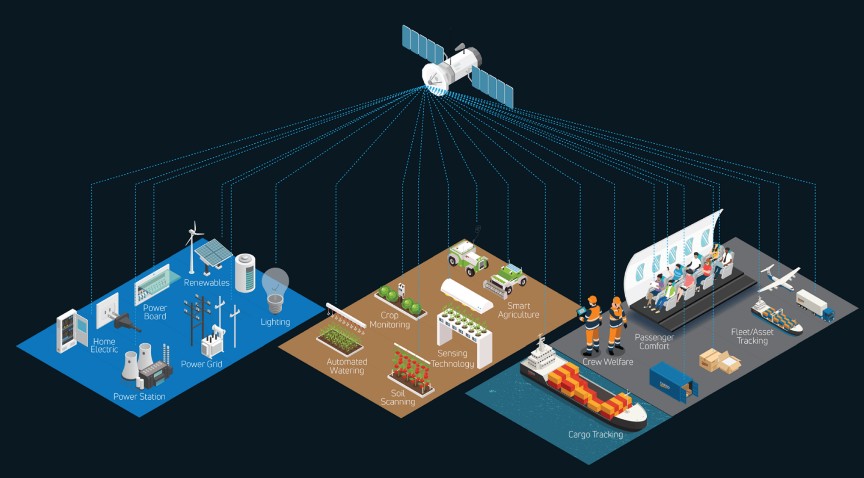Inmarsat is a global satellite communications company that offers a range of solutions for Internet of Things (IoT) applications. Their satellite IoT offerings are designed to provide connectivity in remote and hard-to-reach areas, where traditional cellular or fiber networks are unavailable or unreliable. Here’s a detailed look at Inmarsat’s IoT services and solutions:

An illustration highlighting applications IoT technology and satellite networks deliver to people and businesses across land, sea and air.
IsatData Pro (IDP)
- Service Overview: IsatData Pro is Inmarsat’s global two-way messaging service for machine-to-machine (M2M) communications, which is critical for IoT solutions. It is ideal for low-data-rate applications like asset tracking, monitoring, and controlling systems in remote areas.
- Key Features:
- Supports messages up to 10,000 bytes (10KB) in size, larger than many other satellite IoT solutions.
- Reliable two-way communication.
- Global coverage, including maritime and polar regions.
- Low-power consumption, making it suitable for battery-operated devices in remote locations.
- Use Cases: Asset tracking, smart agriculture, environmental monitoring, and fleet management.
BGAN M2M (Broadband Global Area Network for M2M)
- Service Overview: BGAN M2M is a higher bandwidth IoT solution designed for transmitting large amounts of data in remote areas. It operates over Inmarsat’s L-band satellites and supports real-time monitoring and control of remote sites.
- Key Features:
- Global coverage for IP-based data communications.
- Low power consumption with terminals that can be solar-powered.
- Highly resilient with reliable communications even in adverse weather conditions.
- Capable of transmitting higher amounts of data than IsatData Pro, useful for more data-intensive applications.
- Use Cases: SCADA (Supervisory Control and Data Acquisition) systems in utilities, oil and gas pipelines, environmental monitoring, and critical infrastructure monitoring.
Global Xpress (GX) for IoT
- Service Overview: Global Xpress is Inmarsat’s high-speed Ka-band satellite network that offers broadband connectivity, with global coverage for land, air, and sea. While not strictly an IoT-specific solution, GX is suitable for IoT applications that require high bandwidth, such as video surveillance or real-time data feeds from industrial systems.
- Key Features:
- High-speed broadband connectivity.
- Global coverage with seamless transitions between satellites.
- Can be used for hybrid IoT networks, combining IoT data with real-time monitoring and large-scale data analysis.
- Use Cases: Industrial IoT, smart transportation systems, and high-bandwidth remote applications such as mining, agriculture, and maritime operations.
ELERA Network (L-band)
- Service Overview: ELERA is Inmarsat’s new network specifically designed to support IoT applications. It utilizes the L-band, which is highly resilient and provides global coverage with lower power requirements. ELERA is intended to provide future-proof IoT services and is compatible with both existing and next-generation IoT devices.
- Key Features:
- Enhanced performance for IoT applications.
- Low-power, compact terminals.
- Resilient in extreme weather conditions.
- Designed to support the massive scale of IoT device deployment.
- Use Cases: It supports use cases in agriculture, transportation, logistics, mining, and smart city infrastructure.
Fleet Data
- Service Overview: Fleet Data is Inmarsat’s maritime IoT service. It enables shipping companies to monitor vessel performance in real time, collect data from onboard sensors, and optimize operational efficiency. The system is integrated with Inmarsat’s Fleet Xpress service, providing reliable connectivity for IoT applications at sea.
- Key Features:
- Real-time data transmission from vessels to shore.
- Supports integration with various ship management software.
- Enables predictive maintenance and performance monitoring.
- Use Cases: Maritime IoT applications like fleet management, fuel optimization, and engine performance monitoring.
Key Advantages of Inmarsat’s Satellite IoT Offering:
- Global Coverage: Inmarsat operates a network of geostationary satellites that provide near-global coverage, including remote oceanic and polar regions, which are traditionally underserved by terrestrial networks.
- Reliable and Resilient: Inmarsat’s L-band services, like ELERA and BGAN M2M, are known for their reliability in harsh environments, including areas with extreme weather conditions.
- Low-Power Solutions: Inmarsat’s IoT offerings, particularly IsatData Pro and ELERA, are designed with low-power requirements, making them suitable for battery-operated devices deployed in remote locations.
- Scalability: Inmarsat’s solutions are designed to scale, allowing for the deployment of a few devices or massive IoT networks, depending on the application.
- Flexible Data Plans: They offer flexible data plans that suit various IoT applications, ranging from small data bursts to continuous data streaming for high-bandwidth applications.
Typical Use Cases for Inmarsat IoT Solutions:
- Asset Tracking and Fleet Management: Monitoring and tracking high-value assets like vehicles, ships, or cargo in real-time across the globe.
- Environmental Monitoring: Remote monitoring of environmental factors like weather, water quality, and soil conditions in agriculture and research.
- Utilities and Energy: Supervising and controlling remote energy systems like wind turbines, solar farms, or oil rigs.
- Smart Agriculture: Collecting data from farming equipment, irrigation systems, and livestock sensors to improve farming practices and yields.
Website: Inmarsat
Emerging Trends and Future Prospects:
Inmarsat is heavily investing in expanding its IoT portfolio, particularly through the ELERA network and partnerships with various IoT platform providers. This focus is geared toward scaling its capabilities to meet the growing demand for low-power, wide-area network (LPWAN) solutions for massive IoT deployments. With the advent of 5G and the proliferation of connected devices, Inmarsat is positioning itself as a key player in delivering satellite-enabled IoT services that can integrate with terrestrial networks.
Inmarsat’s satellite IoT offering is particularly valuable for industries that operate in remote or mobile environments where terrestrial connectivity is unreliable or unavailable.